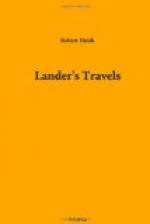“We did not see any where,” says Captain Lyon, “the least appearance of vegetation, but we observed many skeletons of animals, which had died of fatigue in the desert, and occasionally the grave of some human being. All their bodies were so dried by the extreme heat of the sun, that putrifaction did not appear to have taken place after death. In recently dead animals, I could not perceive the slightest offensive smell; and in those long dead, the skin, with the hair on it, remained unbroken and perfect, although so brittle as to break with a slight blow. The sand-winds never cause these carcases to change their places, as in a short time, a slight mound is formed round them, and they become stationary.”
Afterwards, passing between low, table-topped hills, called El Gaaf, the coffle encamped on the third evening in a desert, called Sbir ben Afeen, where the plain presented on all sides so perfect a horizon, that an astronomical observation might have been taken as well as at sea. From the excessive dryness of the air, the blankets and barracans emitted electric sparks, and distinctly crackled on being rubbed. The horses’ tails, also, in beating off the flies, had the same effect.
The fourth day, the route passed over sand lulls to a sandy irregular plain, very difficult and dangerous. Here the wind, being southerly, brought with it such smothering showers of burning sand, that they frequently lost the track, being unable to distinguish objects at the distance of only a few yards.
The next day’s march, the fifth from Sockna, over a rocky country, led to the walled village of Zeighan, or Zeghren, situated in the midst of a large forest of palms, in latitude 27=B0 26’ N. Eight miles further, on basaltic hillocks, is another village, somewhat larger, and more neatly walled, called Samnoo. The houses are very neatly built, and the rooms are washed with a yellow mud, which has a pretty effect. Three tolerably built white-washed minarets, the first that had been seen since leaving Tripoli, rose to some height above the houses, and have a pleasing appearance. Palm trees encircle the town, and the gardens are considered good. This town, as well as Zeighan, is famed for the number and sanctity of its marabouts. A stage of twenty miles, over a barren plain of gravel, leads to another, but inconsiderable town, called Timen-hint. On the next day but one, they reached Sebha, a mud-walled town, picturesquely situated on rising ground, surrounded with its palm groves, in the midst of a dreary, desert plain; it has a high, square, white-washed minaret to its principal mosque. At this place, Captain Lyon remarked a change of colour in the population, the people being mulattoes. Two marches more led to Ghroodwa, a miserable collection of mud huts, containing about fifty people, who appeared a ragged drunken set, as the immense number of tapped palms testified. From the ruins of some large mud edifices, this place




